Enzymes are the commonly used biological sensing element in the fabrication of various biosensors. Enzymes have unique properties and ability to accelerate chemical reactions inside biological cells. Most enzymes react only with specific substrates even though they may be contained in a complicated mixture with other substances. However, it is imperative to keep in mind, that soluble enzymes are very sensitive both to temperature and pH variations, and they can inactivated by many chemical inhibitors. For practical biosensor applications, these enzymes are usually immobilized by insolubilizing the free enzymes via entrapment into an inert and stable matrix such as starch, gel, silicon rubber, or polyacrylamide. This process is essential to ensure that the enzyme retains its catalytic properties and can be reusable.
The action of specific enzymes can be utilized to construct a range of different biosensors. A typical example of an enzyme-based biosensor is a glucose sensor that employs the enzyme glucose oxidase. Glucose plays a key role in metabolic processes. In patients suffering from diabetes mellitus, the pancreas does not produce sufficient amounts of insulin to control adequately the level of glucose in their blood. Hence, to manage the disease, these patients must monitor and regulate their blood glucose level on regular basis by medication and insulin injections. Presently, available glucose sensors are based on an immobilized enzyme such as glucose oxidase that acts as a catalyst. Glucose is detected by measuring electrochemically either the amount of Gluconic acid or Hydrogen peroxide (H2O2) produced or by measuring the amount of oxygen consumed, according to the following chemical reaction:

Glucose and oxygen enter through the outside membrane to allow glucose to interact with the glucose oxidase enzyme. The remaining oxygen penetrates through the second oxygen-permeable membrane and is measured by the oxygen electrode.

The biocatalytic enzyme-based sensors generally consist of an electrochemical gas-sensitive transducer or an ion-selective electrode with an enzyme immobilized in or a membrane that serves as the biological mediator. The analyte diffuses from the bulk sample solution into the biocatalytic layer, where an enzymatic reaction takes place. The electroactive product that is formed (or consumed) is normally detected by an ion-selective electrode. A membrane separates the basic sensor from the enzyme if a gas is consumed (such as O2) or is produced (such as CO2 or NH3). While the concentration of the bulk substrate drops continuously, the rate of consumption is usually insignificant.
Related: What is a Biosensor?
The decrease is detected only when the test volume is very small or when the area of the enzyme membrane is large enough. Therefore, this electrochemical analysis is non-destructive, and the sample can be reused. Measurements are normally performed at a constant pH and temperature either in a stirred medium solution or in a flow-through solution.
Find out more about: Fingertip Pulse Oximeter Blood Oxygen Saturation Monitor
You can also read: Biomedical Sensor Specifications

Leave a Reply
You must be logged in to post a comment.